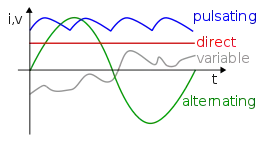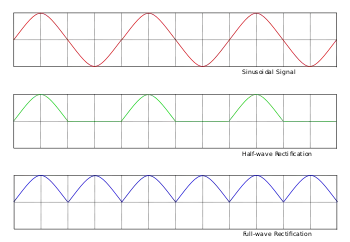Pulsed DC
Pulsed DC (PDC) or pulsating direct current is a periodic current which changes in value but never changes direction. Some authors use the term pulsed DC to describe a signal consisting of one or more rectangular ("flat-topped"), rather than sinusoidal, pulses.[1]


Pulsed DC is commonly produced from AC (alternating current) by a half-wave rectifier or a full-wave rectifier. Full wave rectified ac is more commonly known as Rectified AC. PDC has some characteristics of both alternating current (AC) and direct current (DC) waveforms. The voltage of a DC wave is roughly constant, whereas the voltage of an AC waveform continually varies between positive and negative values. Like an AC wave, the voltage of a PDC wave continually varies, but like a DC wave, the sign of the voltage is constant.
Pulsating direct current is used on PWM controllers.
Smoothing
Most modern electronic items function using a DC voltage, so the PDC waveform must usually be smoothed before use. A reservoir capacitor converts the PDC wave into a DC waveform with some superimposed ripple. When the PDC voltage is initially applied, it charges the capacitor, which acts as a short term storage device to keep the output at an acceptable level while the PDC waveform is at a low voltage. Voltage regulation is often also applied using either linear or switching regulation.
Difference from AC
Pulsating direct current has an average value equal to a constant (DC) along with a time-dependent pulsating component added to it, while the average value of alternating current is zero in steady state (or a constant if it has a DC offset, value of which will then be equal to that offset). Devices and circuits may respond differently to pulsating DC than they would to non-pulsating DC, such as a battery or regulated power supply and should be evaluated.
Uses
Pulsed DC may also be generated for purposes other than rectification. It is often used to reduce electric arcs when generating thin carbon films,[2] and for increasing yield in semiconductor fabrication by reducing electrostatic build-up.[3] It is also generated by the voltage regulators in some automobiles, e.g., the classic air-cooled Volkswagen Beetle.
References
- Chapter 2 of "Introductory Signals and Circuits" by Jose B. Cruz, Jr. and M. E. Van Valkenburg, Blaisdell Publishing Company, 1967.
- http://www.astex.com/eni-rcsi-TN.html
- "Pulsed-DC ionizer".
Bibliography
 This article incorporates public domain material from the General Services Administration document: "Federal Standard 1037C".
This article incorporates public domain material from the General Services Administration document: "Federal Standard 1037C".